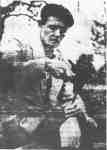Auburn Artist-Poet Utilizes Native Rock in Sculptures
Eleanor Fait
Sculpture from the native rock around Auburn is one of the arts to which Clark Ashton Smith devotes himself. Talc, soapstone, serpentine, sandstone, lava and various types of porphyry within a radius of 15 miles of his home are the materials he uses, many of them new to sculpture.
To lovers of poetry and devotees of weird and fantastic stories, Smith has long been known as one of the outstanding writers of the United States, though his taste for the exotic has, to a certain extent, cut him off from a large audience.
Smith was born in Long Valley, six miles from Auburn, January 13, 1893. His formal schooling consisted of a few years at the district school and completion of the grammar grades in Auburn. He refused to go to high school, wishing to pursue his own line of studies.
Sticks to California
Surprising enough in view of the subject matter of his writing, painting and sculpture, he has not studied in Paris or New York. In fact, he has never been out of California, except for short trips to Nevada. His work has been shown in New York at the Salon des Independents, in San Francisco at Gumps, in Los Angeles and his work has been discussed in Paris art revues.
He lives on "Boulder Ridge," on a 39 acre ranch to which his parents moved in 1902. He has lived there ever since, with brief excursions into other parts of the state.
It is difficult to explain Smith's work in terms of his experience. And though a prodigious reader, he has not come under the influence of any philosophical system or religious idea sufficiently to account for the strange and sometimes macabre subject matter of his art and writing.
Ideas 'Just Come'
When asked about the carving on his figure of The Reptile Man," he says the idea just "came to him." Experts who have examined some of these sculptures state that the hieroglyphics are an ancient language and are translatable.
Smith began to write at the age of 11, fairy tales principally. Edgar Allan Poe's influence on his writings has been apparent since he was 13. He says his first good poetry was written when he was 18, The Star Treader and Other Poems, published in book form. From that time on, he was a regular contributor to various poetry and story magazines of national circulation.
Emily J. Hamilton, a teacher in the Auburn high school, suggested about this time that he contact George Sterling in San Francisco. They became firm friends, Sterling helping Smith with the publication of his first book, reading the proofs and advising him. Of Sterling, Smith says: "He was essentially loveable, gave himself without stint and assisted scores of young poets." Smith doubts that Sterling's death was suicide, says that though he drank heavily and was in pain much of the time, he was eagerly awaiting a visit from H. L. Mencken when his death occurred.
Parents Sympathetic
Smith's parents were sympathetic to his work though there is no record of artists or writers in either branch of the family. His father, Timeus Smith, born in England, was night clerk of the Hotel Truckee for many years. His mother was born in the middle west.
Smith's career has been interrupted numerous times by tuberculosis. He is enjoying good health at present and is planning a trip to New York under the aegis of Benjamin and Bio De Casseres, friends of many years standing.
He is in close contact with his fellow-fantacist, August Derleth and was a friend of H. P. Lovecraft, considered by many the greatest imaginative fiction writer since Poe. Vachel Lindsay began a correspondence with Smith after reading his poetry and the friendship lasted until Lindsay's death in 1937.
Crocker Display
Smith will have 35 carvings and 20 paintings on display in Crocker gallery beginning January 1. He began his experiments in watercolors in 1916 and his sculpture, in 1935, quite by accident.
Visiting his uncle who owned a copper mine near Lincoln, he picked up a piece of talc, took it home, and casually carved it into a figure one day. Pleased by the result, since then, he has done more than 200 pieces.
Smith next sculpture will be a series of figures based on his own conception of the gods of classical mythology. His latest book, The End of the Story, will be issued by Arkham House next spring.
An interesting item that will be included in his Crocker show is a copy of his translations of Baudelaire included in the Flowers of Evil printed by the Limited Editions club of New York and illustrated by Jacob Epstein, famous London sculptor and artist.
[Reprinted from the Sacramento Union, 21 December 1941]
